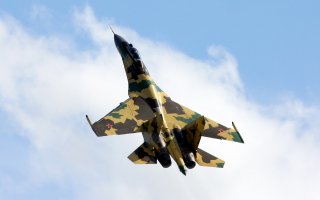Russia’s SU-35 Is a Killing Machine without a Target
There are, unfortunately for eager Russian pilots, no enemy fighter planes over Syria.
Here's What You Need To Remember: While other Russian jets such as the Su-30SM and the outstanding Sukhoi Su-34 Fullback bomber have had a chance to show off their capabilities in the air-to-ground realm in Syria, the Su-35 has not.
Earlier this year, Russia’s potent Sukhoi Su-35 Flanker-E air superiority fighter entered service with the Chinese People’s Liberation Army Air Force (PLAAF).
The PLAAF is the second major air arm after the Russian Aerospace Forces to deploy the new fighter.
United Aircraft Corporation—Sukhoi’s parent company—has also secured a contract with Indonesia to deliver 11 Su-35 fighters for $1.4 billion with deliveries expected to start this October.
Other potential operators are slowly lining up to purchase to powerful Russian-made fighter, but the jet has not enjoyed the export success of the somewhat less advanced two-seat Su-30MK and Su-30SM Flanker-H variants.
Part of the problem for the Russians is that while the Su-35S has performed well over Syria, the aircraft has not had an opportunity to face off against other enemy aircraft and show off its potential. The Russian air group in Hmeimim does not have to contend with a real air threat over Syria because neither the Syrian rebels nor what remains of ISIS has any airpower to speak of. And while there is some potential for an aerial confrontation with Western air forces in the region, that risk is mitigated by the U.S.-Russia deconfliction line and the fact that neither the side is willing to risk direct hostilities with each other.
As such, while other Russian jets such as the Su-30SM and the outstanding Sukhoi Su-34 Fullback bomber have had a chance to show off their capabilities in the air-to-ground realm, the Su-35 has not.
Thus, United Aircraft Corporation and its Sukhoi subsidiary have not gained quite as much from the Syria campaign in terms of operational experience and marketing benefits for the Su-35 as they have for the Su-30SM and Su-34, both of which are conducting strikes with precision-guided weapons day in and day out.
The Kremlin is not shy about stating exactly how important the Syria campaign is for Russia’s defense industry.
“When we started to use these modern weapons, including missiles, whole teams from our defense industry companies went to Syria, and worked there on-site—it is extremely important for us—to finalize them and figure out what we can count on when using them in combat conditions,” Russian president Vladimir Putin said during a televised public question and answer session on June 7.
Left unsaid, however, is the campaign’s utility as a marketing tool for new Russian weapons that are proving themselves in Syria.
Indeed, all manner of Russian weapons—including those that have not even entered production—have been tested in Syria. Testing that hardware in Syria not only helps the Russians to glean valuable test data on the performance of the weapons and to improve those systems, it also serves as a demonstration of those capabilities for potential customers.
Recommended: China's H-6K: The 'Old' Bomber That Could 'Sink' the U.S. Navy
Recommended: Why an F-22 Raptor Would Crush an F-35 in a 'Dogfight
Recommended: Air War: Stealth F-22 Raptor vs. F-14 Tomcat (That Iran Still Flies)
While Russia did gain valuable operational experience operating the Su-35 over Syria, those operations did not produce readily visible effects—which does not help with marketing.
Nonetheless, the Sukhoi Su-35S Flanker-E is the most potent fighter currently in operation with the Russian Air Force and offers good capability at reasonable prices. The airframe is high flying, fast, and carries an enormous payload. That, combined with its advanced suite of avionics, makes the Su-35 an extremely dangerous foe to any Western fighter, with the exception of the stealthy Lockheed Martin F-22 Raptor.
It is only a matter of time before the Russians manage to sell more of these jets around the world—especially to those nations that either do not want to or are unable to buy Western aircraft.
This piece first appeared in 2018 and is being reprinted due to reader interest.
Image: Reuters.

